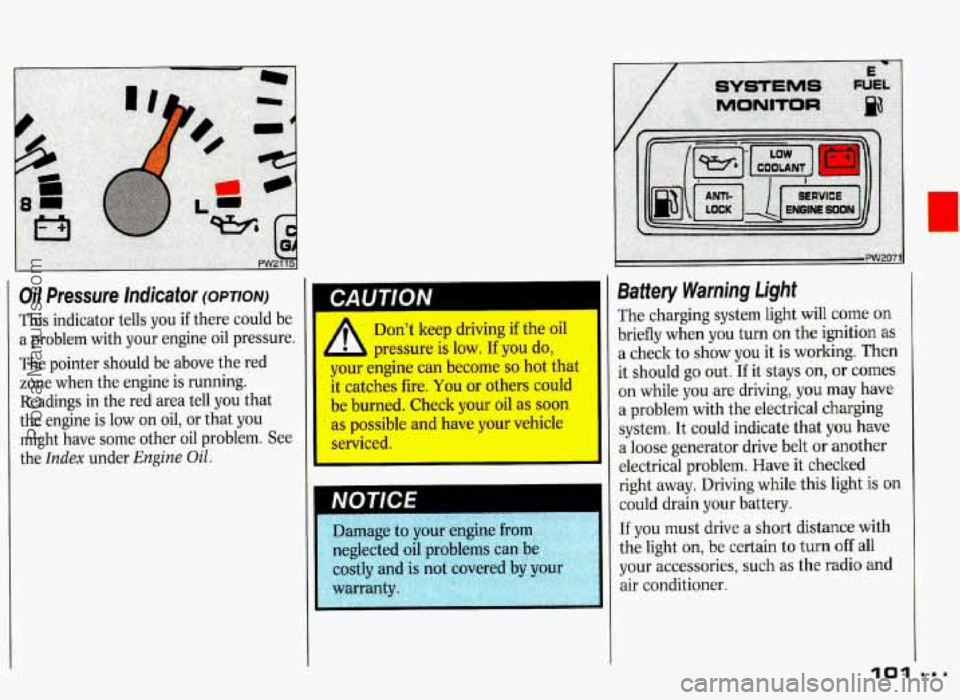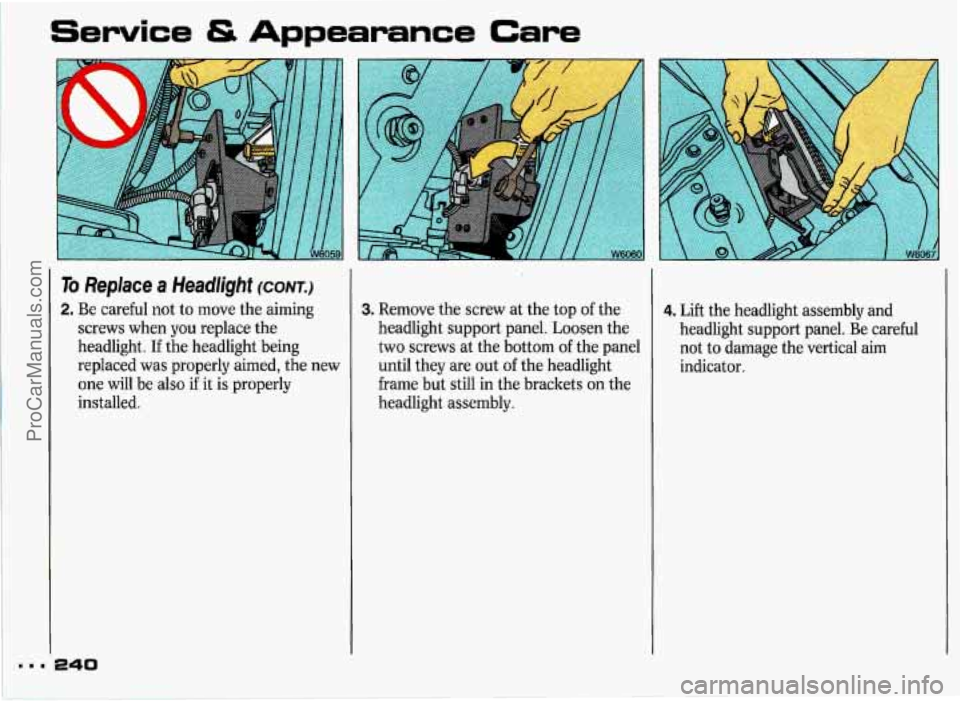1993 PONTIAC GRAND-PRIX service indicator
[x] Cancel search: service indicatorPage 98 of 338

Tachometer (OPTION)
The tachometer displays the engine
speed in revolutions per minute
(rpm).
-
NU I IL't
Fuel Gage
You have one of the fuel gages shown.
The fuel gage tells you about how much
fuel you have left, when the ignition is
on. When the indicator nears E (Empty),
you still have a little fuel left, but you
should get more
soon.
Here are three things that some owners
ask about. None of these show a
problem with your fuel gage:
At the gas station, with your ignition
on, the gas pump shuts off before the
gage reads
F (Full).
It takes a little more or less fuel to fill
up than the gage indicated. For
example, the gage may have indicated
the tank was half full, but
it actually
took a little more
or less than half the
tanks capacity to fill the tank.
The gage moves a little when you turn
a corner
or speed up.
For your fuel tank capacity, see
Service
Station
Information on the last page of
this manual.
a7
ProCarManuals.com
Page 102 of 338

Oil Pressure Indicator (OPTION)
This indicator tells you if there could be
a problem with your engine oil pressure.
The pointer should be above the red
zone when the engine is running.
I CAUTION
Readings in the red area tell you that
the engine is low on oil, or that you
might have some other oil problem. See
the
Index under Engine Oil.
Don't keep driving if the oil
pressure is low.
If you do,
your engine can become
so hot that
it catches fire, You or others could
be burned. Check your oil as soon
as possible and have your vehicle
serviced.
Battery Warning Light
The charging system light will come on
briefly when you turn on the ignition
as
a check to show you it is working. Then
it should go out.
If it stays on, or comes
on while you are driving, you may have
a problem with the electrical charging
system. It could indicate that
you have
a loose generator drive belt
or another
electrical problem. Have it checked
right away. Driving while this light
is on
could drain your battery.
If you must drive a short distance with
the light
on, be certain to turn off all
your accessories, such as the radio and
air conditioner.
101
ProCarManuals.com
Page 150 of 338

I
You can steer around the obstacle while To Use Anti-Lock Don’t pump the
braking hard.
brakes. Just hold the brake pedal down
As you brake, your computer keeps and
let anti-lock work for you. You also
receiving updates on wheel speed and
may hear a cliclting noise as you
controls braking pressure accordingly. accelerate
after a hard stop.
Anti-lock doesn’t change the
time you need to get your
foot up to the brake pedal. If you
get too close to the vehicle in front
of you,
you won’t have time to
apply your braltes
if that vehicle
suddenly slows or stops. Always
leave enough
room up ahead to
stop, even though you have
anti-lock brakes.
Disc Brake Wear Indicators
Your Pontiac has four-wheel disc
braltes. Disc brake pads have built-in
wear indicators that make a high-
pitched warning sound when the brake
pads are worn and new pads are needed.
The sound may come and go,
or be
heard all the time your vehicle
is moving
(except when you are pushing on the
brake pedal firmly).
I
A The brake wear warnin&
sound means that sooner
or
later your brakes won’t work well,
That could lead
to an accident.
When you hear the brake wear
warning sound, have
your vehicle
serviced.
ProCarManuals.com
Page 224 of 338

When to Change Engine Oil
See if any one of these is true for you:
Most trips are less than 4 miles
(6 la).
It’s below freezing outside and most
trips are less than 10 miles (16
km).
The engine is at low speed most of the
time (as in door-to-door delivery, or in
stop-and-go traffic).
You tow a trailer often.
Most trips are through dusty places.
If any one of these is true for your
vehicle, then
you need to change your
oil and filter every 3,000 miles (5 000 km)
or 3 months-whichever comes first.
See the
Index under Oil Change
Indicator.
If none of them is true, change the oil
every
7,500 miles (12 500 km) or 12
months-whichever comes first. Change the filter at the first oil change
and at every other oil change after that.
If you have the STE, you have an oil
change indicator in the Driver
Information Center. See the
Index
under Driver Information Center.
Engine Block Heater
An engine block heater can be a big
help if you have to park outside in very
cold weather,
0°F (-18°C) or colder. If
your vehicle has this option, see the
Index under Engine Block Heater.
What to Do with Used Oil
CAUTION
* Used engine oil contains
L things that have caused skin
callcer in laboratory animals. Don’t
let used oil stay on your skin for
very long. Clean your skin and nails
with soap and water,
or a good
hand cleaner. Wash or properly
throw away clothing or rags
containing used engine oil.
Used oil can be a real threat to the
environment.
If you change your own
oil, be sure to drain all free-flowing oil
from the filter before disposal. Don’t
ever dispose of oil by pouring it on the
ground, into sewers, or into streams or
bodies of water. Instead, recycle it by
taking it to a place that collects used oil.
If you have a problem properly
disposing of your used oil, ask your
dealer, a service station
or a local
recycling center for help.
223
ProCarManuals.com
Page 239 of 338

Service lS Appearance C
Checking Aim of the Headlights
(CONT.)
To make sure your headlights are
aimed properly, read all the
instructions before beginning.
Failure to follow these instructlons
could cause damage to headlight
parts.
State inspection stations will allow a
vertical reading of up plus .76 degrees
or down minus
.76 degrees €or the
center of the bubble.
It is recommended that the upper limit
not exceed up plus
.4 degrees for the
center of the bubble. There may be
an
increased chance of being flashed if
adjustment is much above
up plus
.4 degrees.
Aiming HeadJishts
(2-DOOR MODELS)
To check the aim, the vehicle should be
properly prepared as follows:
The vehicle must have all four tires on
a perfectly level surface.
The vehicle should not have any
snow, ice or mud attached to it.
There should not be any cargo or
loading
of vehicle, except it should
have a full tank
of gas and one person
or
160 pounds (75 kg) on the driver’s
seat.
Tires should be properly inflated.
The horizontal indicator should read
0 (zero).
ProCarManuals.com
Page 241 of 338

Service & Appearance Care
, M.8
To Replace a Headlight (CONT.)
2. Be careful not to move the aiming
screws when you replace the
headlight. If the headlight being
replaced was properly aimed, the new
one will be also
if it is properly
installed.
240
3. Remove the screw at the top of the
headlight support panel. Loosen the
two screws at the bottom
of the panel
until they are out
of the headlight
frame but still in the brackets on the
headlight assembly.
4. Lift the headlight assembly and
headlight support panel. Be careful
not to damage the vertical aim
indicator.
ProCarManuals.com
Page 258 of 338

When It’s Time for New Tires
One way to tell when it’s time for new
tires is to check the treadwear
indicators, which will appear when your
tires have only
2/32 inch (1.6 mm) or
less
of tread remaining.
You need a new tire if:
You can see the indicators at three
You can see cord or fabric showing
The tread or sidewall is cracked, cut
places
around the tire.
through the tire’s rubber.
or snagged deep enough to show cord
or fabric.
The tire has a bump, bulge or split.
The tire has a puncture, cut, or other
damage that can’t
be repaired well
because
of the size or location of the
damage.
Buying New Tires
To find out what kind and size of tires
you need, look at the Tire-Loading
Information label. The tires installed on
your vehicle when it was new had a Tire
Performance Criteria Specification
(TPC Spec) number on each tire’s
sidewall. When
you get new tires, get
ones with that same
TPC Spec number.
That way, your vehicle will continue to
have tires that are designed to give
proper endurance, handling, speed
rating, traction, ride and other things
during normal service on your vehicle.
If your tires have an all-season tread
design, the
TPC number will be
followed by a
“MS” (for mud and
snow). If
you ever replace your tires with those
not having a
TPC Spec number, make
sure they are the same size, load range,
speed rating and construction type
(bias, bias-belted or radial) as your
original tires.
‘1 Mixing tires could cause you
A to lose control while driving.
If you mix tires
of different sizes or
types (radial and bias-belted tires),
the vehicle may not handle
properly, and you could have a
crash. Be sure to use the same size
and type tires on all wheels. It’s all
right to drive with your compact
spare, though. It was developed for
limited use on vour vehicle.
r
257 =a
ProCarManuals.com
Page 297 of 338

Maintenance Schedule
Section A: Scheduled Maintenance Services t~ont.3
Explanation of Scheduled Maintenance Services
Below are explanations of the services listed in Schedule I
and Schedule 11.
ITEM
NO. SERVICE
1 Engine Oil and Filter Change’:-Always use SG
Energy Conserving I1 oils for proper viscosity. The
“SG” designation may be shown alone or in
combination with others, such as “SG/CC,”
“SG/CD” or
“SF, SG, CC,” etc. To determine the
preferred viscosity for your vehicle’s engine (e.g.,
SAE
5W-30 or SAE 1OW-30) see the Index under
Engine OiZ. If your vehicle is equipped with an
Engine Oil-Change Indicator (EOCI)
, the
indicator will show you when to change oil. See
the
Index under Driver Information Center.
2 Chassis Lubrication-Lubricate the transaxle shift
linkage, parking brake cable guides, underbody
contact points and linkage. Lubricate the front and
rear suspension and steering linkage. The
proper fluids and lubricants to use are listed in Section
D. Make sure whoever services your vehicle uses these. All
parts should be replaced and all necessary repairs done
before you or anyone else drives the vehicle.
ITEM
NO. SERVICE
3 Throttle Body Mounting Bolt Torque (3.1L
Code T engine only)‘x- Check the torque of the
mounting bolts and/or nuts.
Tire and Wheel Rotation and Inspection -For
long wear and maximum tire life, rotate your tires
following the instructions in this manual. See the
Index under Tires, Inspection G. Rotation. Check
the tires for uneven wear or damage.
If you see
irregular or premature wear, check the wheel alignment. Check for damaged wheels also.
4
a The U.S. Environmental Protection Agency has determined that the failure to perform this maintenance item will not nullify the emission warranty or
limit recall liability prior to the completion of vehicle useful life. General Motors, however, urges that all recommended maintenance services be
performed at the indicated intervals and the maintenance be recorded
in Section E: Maintenance Record.
296
ProCarManuals.com